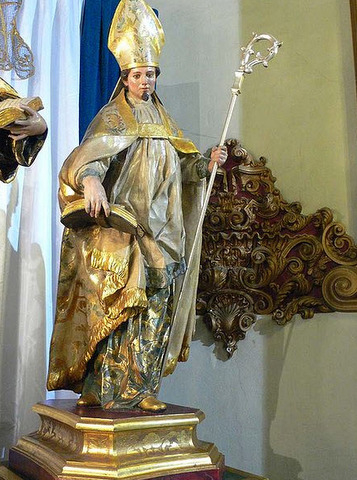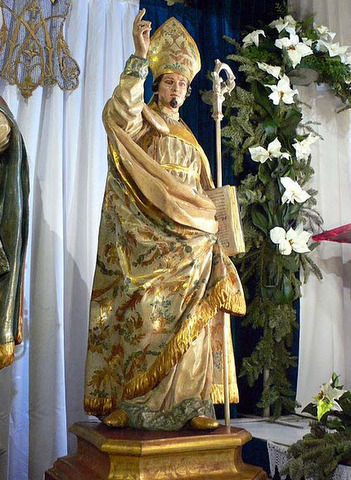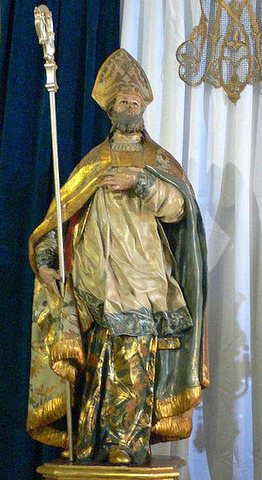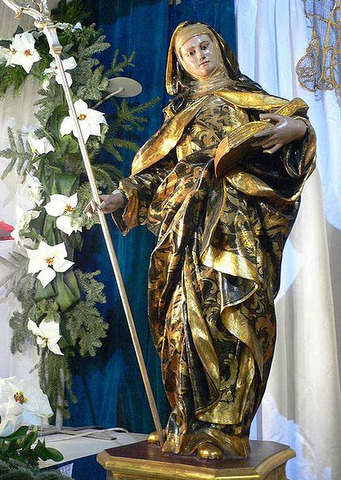-


 Welcome To
Welcome To CARTAGENA
CARTAGENA
 A must do visit
A must do visit The Roman TheatreCartagenaClick Here for more information
The Roman TheatreCartagenaClick Here for more information
 Welcome To
Welcome To CARTAGENA
CARTAGENA article_detail
article_detailCartagena and the four saints
Los Cuatro Santos de Cartagena: San Leandro, San Fulgencio, Santa Florentina and San Isidoro
 The four saints of Cartagena are San Leandro, San Fulgencio, Santa Florentina and San Isidoro, four names which will be familiar to those who have spent time both in and around Cartagena, names which are used not only for streets, but also military batteries, hospitals and schools.
The four saints of Cartagena are San Leandro, San Fulgencio, Santa Florentina and San Isidoro, four names which will be familiar to those who have spent time both in and around Cartagena, names which are used not only for streets, but also military batteries, hospitals and schools.
These four people were born at a time when the Visigoths occupied not only Cartagena, but also much of the southern area of Spain. ( See History of Cartagena )The Visigoths were Christians, but followed what is known as Arianist Christianity when they invaded Spain, ( see information about Begastri in Cehegín for a full explanation of what that means)although as time moved on , accepted a more orthodox form of christianity, part of that due to the four saints, who came from an influential and powerful family living in Carthago Nova ( Cartagena) at the time.
Although the Visigoths held power in this area, a deal was done with the Byzantines, who represented the Western Roman Empire, one of the segments created when the Roman Empire divided, and were based in Constantinople. The Byzantines took Cartagena in exchange for military aid and used it to found the province of Spania in 555 with the aim of re-establishing the Western Roman Empire, and included the coast from Carthago Nova (Cartagena) to Malaca (Málaga), the Balearic Isles and the inland area between Astigi (Écija) and Basti (Baza).The province was ruled by a “magister militum Spaniae”, a civil and military governor who was appointed by the Emperor of Byzantium. When the Visigoths lost Carthago Nova this brought about the capital of the Carthaginensis province ( the Visigoth kingdom which included this area) being moved to Toletum (Toledo), and Begastri (Cehegín) became the Episcopal seat.
 Meanwhile, the Byzantines, who were Christians, made Carthago Nova their Episcopal seat and the capital of the province of Spania, re-naming it Carthago Spartaria and undertaking a total reconstruction of the city. Carthago Spartaria was to remain the Episcopal seat throughout the Byzantine rule which only lasted 50 years: politics moves on.
Meanwhile, the Byzantines, who were Christians, made Carthago Nova their Episcopal seat and the capital of the province of Spania, re-naming it Carthago Spartaria and undertaking a total reconstruction of the city. Carthago Spartaria was to remain the Episcopal seat throughout the Byzantine rule which only lasted 50 years: politics moves on.The Visigoths saw the province of Spania as a threat to their dominance in the peninsula, and in the second half of the 6th century King Leovigildo conquered the Byzantines in the inland areas. King Sisebuto then took Malaca and Carthago Spartaria from them at the start of the 7th century, destroying the city of Carthago Spartaria: San Isidoro lamented that “only the ruins” remained. The Byzantines were finally expelled from Hispania by King Suintilla in the year 622.
One of the consequences of the Byzantines taking control of Carthago Nova was that the family of the four saints of Cartagena, San Leandro, San Isidoro, San Fulgencio and Santa Florentina, was exiled to Seville.
 San Leandro was the bishop of Híspalis (Sevilla), and fought against the Arianist cult: among his converts to Catholicism were Hermenegildo, the governor of the Bética province and son of King Leovigildo, and King Recaredo, who converted at the 3rd Council of Toledo in 589.
San Leandro was the bishop of Híspalis (Sevilla), and fought against the Arianist cult: among his converts to Catholicism were Hermenegildo, the governor of the Bética province and son of King Leovigildo, and King Recaredo, who converted at the 3rd Council of Toledo in 589.
San Isidoro was also Bishop of Híspalis, and advanced the cultural education of the clergy as well as the unification of the liturgy at the 4th Council of Toledo in 633. The 7th Council of Toledo paid homage to him as “the extraordinary doctor, the last ornament of the Catholic church, the most erudite man of recent times, whose name is always revered”.
San Fulgencio was the bishop of Cartago Nova (Cartagena) as well as being named Doctor of the Church by Pope Pius IX in 1880.
Santa Florentina, for her part, was an abbess who founded forty monasteries in Hispania.
The mortal remains of San Isidro were laid to rest in the basilica which is named after him in León in the 11th century, while those of San Leandro, San Fulgencio and Santa Florentina lie in a silver urn in the cathedral of Murcia.
The four saints are also depicted in stone in the fachada of the Cathedral in Murcia.
Francisco Salzillo and the four saints of Cartagena
In 1755 Murcian sculptor, Francisco Salzillo was commissioned to create four figures representing the three brothers and sister, the Four saints of Cartagena, San Leandro, San Fulgencio, Santa Florentina and San Isidoro.
The four sculptures were originally located in a chapel in the Old Cathedral of Cartagena, along with the former patron of the City, the Virgen del Rosell.
The sculptor himself was so proud of these four works that he actually came to Cartagena to present them himself, said to be the only occasion on which he left Murcia.
Fortunately, these four figures escaped the wholesale destruction of the Spanish Civil War, in which dozens of Salzillos were destroyed during fires set in the churches during 1936.
Today the four saints can be seen inside the Iglesia de Santa María de Gracia.
Voto a los Cuatro Santos y a la Virgen del Rosell.
 Each year in November the Council of Cartagena carries out a traditional act known as the Voto a los Cuatro Santos y a la Virgen del Rosell.
Each year in November the Council of Cartagena carries out a traditional act known as the Voto a los Cuatro Santos y a la Virgen del Rosell.
This commemorates a terrible storm, the Borrasca de Santa Catalina which took place on the 24th November in 1694, which threatened to demolish the whole city, such was the force of the storm and floodwaters.
The residents prayed to the four saints of Cartagena San Leandro, San Fulgencio, Santa Florentina and San Isidoro and the Virgen del Rosell ( after whom the Rosell hospital is named) and miraculously, Cartagena was saved.
Each year a service is held in the Iglesia de Santa María de Gracia in Cartagena, which houses four images of the saints, carved by master sculptor, Francisco Salzillo.
Mass is celebrated giving thanks to the saints, and a floral offering is given following the service.
Images: Nono Sánchez
article_detail
article_detailContact Spanish News Today: Editorial 966 260 896 / Office 968 018 268

To be listed on the CAMPOSOL TODAY MAP please call +34 968 018 268.

To be listed on the CONDADO TODAY MAP please call +34 968 018 268.

Guidelines for submitting articles to Camposol Today
Hello, and thank you for choosing CamposolToday.com to publicise your organisation’s info or event.
Camposol Today is a website set up by Murcia Today specifically for residents of the urbanisation in Southwest Murcia, providing news and information on what’s happening in the local area, which is the largest English-speaking expat area in the Region of Murcia.
When submitting text to be included on Camposol Today, please abide by the following guidelines so we can upload your article as swiftly as possible:
Send an email to editor@camposoltoday.com or contact@murciatoday.com
Attach the information in a Word Document or Google Doc
Include all relevant points, including:
Who is the organisation running the event?
Where is it happening?
When?
How much does it cost?
Is it necessary to book beforehand, or can people just show up on the day?
…but try not to exceed 300 words
Also attach a photo to illustrate your article, no more than 100kb












